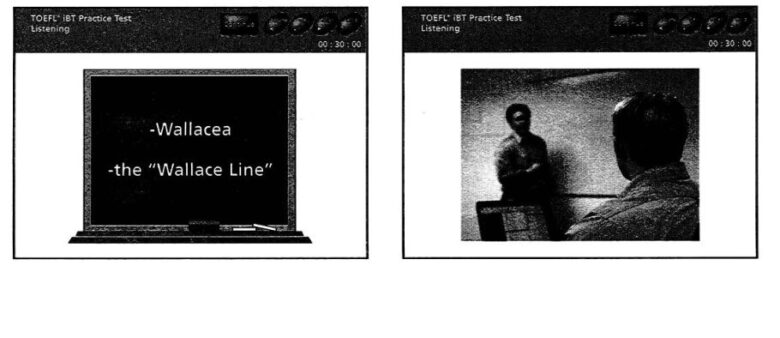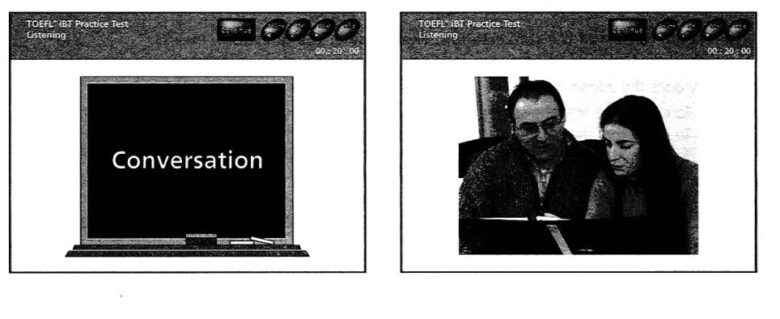TOEFL IBT Listening Practice Test 22 from Sharpening Skills for the TOEFL iBT four practice tests by Jeff Zetter & Micheal Pederson
Listening Section Directions
This test measures your ability to understand conversations and lectures in English.The Listening section is divided into 2 separately timed parts. In each part you will listen to 1 conversation and 2 lectures. You will hear each conversation or lecture only one time.
After each conversation or lecture, you will answer questions about it. The questions typically ask about the main idea and supporting details. Some questions ask about a speaker’s purpose or attitude. Answer the questions based on what is stated or implied by the speakers.
You may take notes while you listen. You may use your notes to help you answer the questions. Your notes will not be scored. If you need to change the volume while you listen, click on the Volume icon at the top of the screen.
In some questions, you will see this icon: This means you will hear, but not see, part of the question. Some of the questions have special directions. These directions appear in a gray box on the screen.
Most questions are worth 1 point. If a question is worth more than 1 point, it will have special directions that indicate how many points you can receive. You must answer each question. After you answer, click on Next. Then click on OK to confirm your answer and go on to the next question. After you click on OK, you cannot return to previous questions.
A clock at the top of the screen will show you how much time is remaining. The clock will not count down while you are listening. The clock will count down only while you are answering the questions.
TOEFL IBT Listening Practice Test 22 from Sharpening Skills for the TOEFL iBT four practice tests by Jeff Zetter & Micheal Pederson
Listening 1
Listen to part of a lecture in a biology class. Track 1
Now get ready to answer the questions. You may use your notes to help you answer.
1. What is the lecture mainly about? Track 2
(A) The differences between Asian and Australian species
(B) A zoogeographic region
(C) Evidence that Wallace’s methods were correct
(D) A theory of evolution
2. What is the significance of the Wallace Line? Track 3
(A) It marks the geological boundary between the Asian and Australian continents.
(B) It is an example of how Wallace proved the theory of evolution.
(C) It marks the boundary between the Asian and Australian zoogeographic regions.
(D) It is an example of a zoogeographic core and a periphery.
3. Why does the professor mention the islands of Bali and Lombok? Track 4
(A) To illustrate that species can only cross narrow gaps between islands
(B) To give an example of how gene pools separate
(C) To give an example of natural selection among birds and mammals
(D) To explain how Wallace arrived at his discovery
4. According to the lecture, which of the following statements about Wallacea are true? Track 5
Put an X in the YES or NO column for each statement.
Yes No
(A) It contains species primarily from the Asian region.
(B) It acts as a sort of transition zone between larger regions.
(C) Insects are the only animals from Australia found there.
(D) It is unigue for the huge diversity present in a small area.
5. According to the professor, what is the relationship between a gene pool and a zoogeographic region? Trade 6
(A) The same gene pools can be found in nearby zoogeographic regions.
(B) Gene pools are smaller versions of a zoogeographic region.
(C) Zoogeographic regions are composed of many gene pools.
(D) Different zoogeographic regions house different gene pools.
Listen again to part of the lecture. Then answer the question. Trade 7
6. Why does the professor say this: ?
(A) He will describe the line somewhat differently from Wallace.
(B) He wants to illustrate how the line works in theory.
(C) He is explaining how excited Wallace was about the discovery.
(D) He intends to prove that Wallace’s observations were correct.
Listening 2
Listen to part of a conversation between a student and a clerk at the student union. Track 8
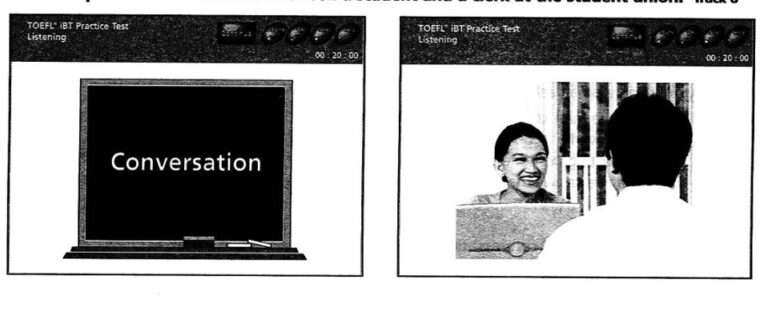
Now get ready to answer the questions. You may use your notes to help you answer.
7. What are the speakers mainly discussing? Track 9
(A) The high price of athletic tickets
(B) Ways for students to save money on university events
(C) Buying tickets for a football game
(D) Illegal use of student tickets
8. What reason is given for reserving some seats just for students? Track 10
(A) Students should not be squeezed out of games.
(B) Non-students shouldn’t come to university events.
(C) Families should be encouraged to attend games together.
(D) University events are expensive.
9. According to the woman, how might the student’s family attend the game? Choose 2 answers. Track 11
(A) They could buy non-student tickets.
(B) They could visit the Student Union for guest passes.
(C) They could use tickets bought by students.
(D) They could dress and act like students.
10. Which of the following is one of the student’s worries? Track 12
(A) His parents might be stopped at the stadium gates.
(B) He won’t be able to find the athletic ticket office.
(C) His friends will keep their tickets for themselves.
(D) The game might be canceled because of bad weather.
Listen again to part of the conversation. Then answer the question. Track 13
11. Why does the woman ask the man this: ?
(A) To ensure the man knows where the ticket office is
(B) To see if he wants to go to the football game with her
(C) To avoid wasting her time teaching him about football
(D) To check if he knows the rules about student tickets
Listen again to part of the conversation. Then answer the question. Track 14
12. What does the woman think about the information she has given the student?
(A) It is untrue.
(B) It is valuable.
(C) It may be inaccurate.
(D) It may be illegal.
Listening 3
Listen to part of a talk in a film class. Track 15
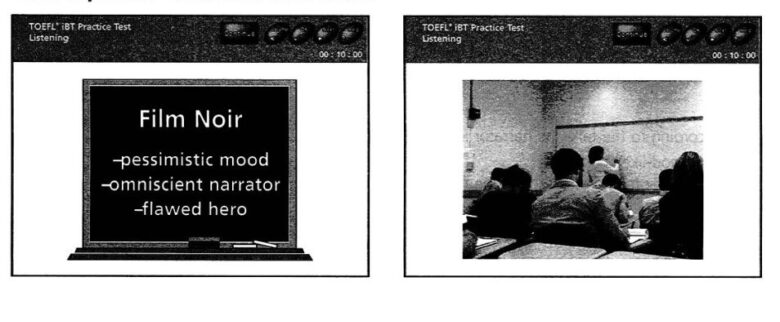
13. What is the main topic of the talk? Track 16
(A) Famous movies in the film noir genre
(B) How film noir got its name
(C) Characteristics of film noir
(D) Film noir characters
14. Which point does the professor illustrate by mentioning Citizen Kane? Track 17
(A) The social value of film noir
(B) The pessimism of the noir hero
(C) The viewpoint of the omniscient narrator
(D) The use of flashbacks in film noir
15. Which characteristics are true of film noir? Track 18
Put an X in the YES or NO column for each statement.
Yes No
(A) Vivid music
(B) Dramatic lighting
(C) A dark mood
(D) A virtuous hero
16. Which statement best expresses the professor’s attitude toward the mood of film noir?
Track 19
(A) It reflects the low morale in America at the time.
(B) French critics misunderstood the mood when they named the genre.
(C) It is not strongly related to real human feelings.
(D) Its extreme darkness kept the films from being successful.
17. According to the talk, the narrator in a noir film is likely to be Track 20
(A) a god-like character
(B) a person who dies early in the film
(C) an attractive female
(D) a speaker who knows all aspects of the story
Listen again to part of the talk. Then answer the question. Track 21
18. Why does the professor ask this: ?
(A) Some of the best noir films are French.
(B) She doesn’t know what the term means in French.
(C) Film noir is a French term.
(D) She wants to better understand her students.
Listening 4
Listen to part of a discussion in a sociology class. Track 22
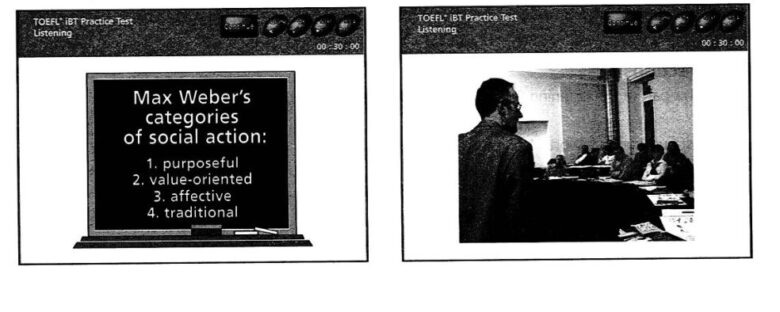
1. What is the discussion mainly about? Track 23
(A) Weber’s theories of rational action
(B) Weber’s typology of social action
(C) Weber’s analysis of social change
(D) Weber’s sociological experiments
2. Which of the following is a characteristic of classical economic rationality? Track 24
(A) It underestimates the role of rational decision-making.
(B) It claims that decisions must be meaningful to actors.
(C) It is narrowly focused on the rational pursuit of material self-interest.
(D) It is similar to Weber’s idea of value rationality.
3. Why do the students talk about the monk? Track 25
(A) To explain the concept of holiness
(B) To give an example of affective action
(C) To illustrate the concept of value-rational action
(D) To suggest that monks are not rational
4. According to the discussion, actions based on value rationality Track 26
(A) are sometimes good and sometimes bad
(B) are based on emotion, not reason
(C) have ethical or moral goals
(D) are made outside a social context
Listen again to part of the discussion. Then answer the question. Track 27
5. Why does the professor say this: ?
(A) To correct a mistake he just made
(B) To explain a term he just introduced
(C) To give an example of value-oriented rationality
(D) To check if students understand the key concepts
Listen again to part of the discussion. Then answer the question. Track 28
6. What can be inferred about the student’s attitude about her roommate?
(A) Her roommate is not very goal-oriented.
(B) Her roommate had weak reasons for choosing this college.
(C) Her roommate is more socially successful than she is.
(D) She and her roommate don’t share similar interests.
Listening 5
Listen to part of a conversation between a student and a university advisor. Track 29
Now get ready to answer the questions. You may use your notes to help you answer.
7. Why does the student go to talk to her advisor? Track 30
(A) She has to switch majors this semester.
(B) She has trouble finding the language lab.
(C) She doesn’t like her computer teacher.
(D) She is worried about her language classes.
8. Which class is a requirement for the woman’s major? Track 31
(A) Chinese (B) French
(C) Spanish (D) German
9. What does the woman say about herself? Track 32
(A) She doesn’t like working with other people.
(B) She doesn’t have time to practice languages.
(C) She is not good at using computers.
(D) She is not a hard worker by herself.
10. According to the advisor, which of the following are features of the new language lab? Track 33
Put an X in the YES or NO column for each statement.
Yes No
(A) Students can record their voices.
(B) Students can work together using computers.
(C) Students who use it do not have to attend classes.
(D) Students can practice with people from other countries.
11. What is the woman’s attitude toward using computers to study? Track 34
(A) She would rather study with people.
(B) She doesn’t like using computers at all.
(C) She would rather use tape players.
(D) She thinks she uses computers too much.
Listen again to part of the conversation. Then answer the question. Track 35
12. Why does the advisor say this: ?
(A) To emphasize that the student should study harder
(B) To show that the student can pass her classes
(C) To recommend using the language lab
(D) To describe the useful features of the language lab
Listening 6
Listen to part of a talk in a physical science class. Track 36
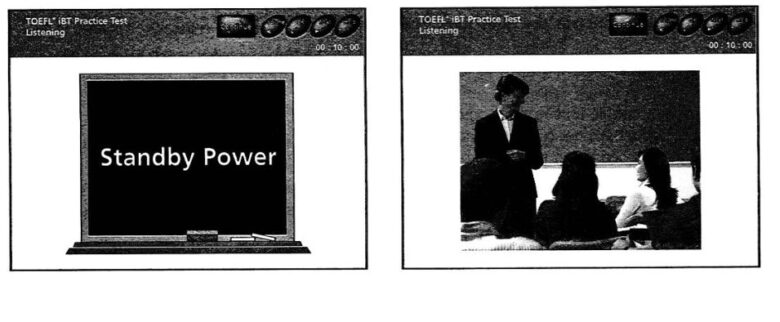
13. What is the talk mostly about? Track 37
(A) Environmentally friendly technology
(B) Different approaches to solving pollution problems
(C) Energy consumed by standby modes
(D) Household energy usage
14. Why does the professor start by discussing the microcosm instead of discussing large, industrial polluters? Track 38
(A) Industrial polluters do not harm the environment as much as his students.
(B) He wants students to think about how their own lives affect the environment.
(C) Industrial polluters pay his salary, so he does not want to anger them.
(D) He has already discussed industrial polluters in previous lectures.
15. Which statement best describes the Energy Star program? Track 39
(A) It provides consumers with a way to judge the energy efficiency of products.
(B) It is a program legislated by the government to regulate energy use.
(C) It has reduced standby power consumption in the US.
(D) It forces industry to make more efficient microwave ovens.
16. Which statement best describes the attitudes of the two students? Track 40
(A) The students both agree on how to solve the problem.
(B) One of the students does not think there is a solution to the problem.
(C) One of the students favors a mandatory solution to the problem.
(D) One of the students considers the problem more serious than the other student.
Listen again to part of the talk. Then answer the question. Track 41
17. Why does the professor ask the student this: ?
(A) She is not going to give the student information if the student won’t believe it.
(B) She is emphasizing that the truth is different from what the student expects.
(C) She is trying to find out if the student did the reading for the dass.
(D) She is indicating that the student is correct in his assumption about energy use.
Listen again to part of the talk. Then answer the question. Track 42
18. What does the professor imply about Lawrence Berkeley National Laboratory?
(A) It’s in the forefront in developing standby power.
(B) It’s a well-respected research facility.
(C) Its focus is investigating environmentally friendly technology.
(D) It profits from the work of its scientists.


